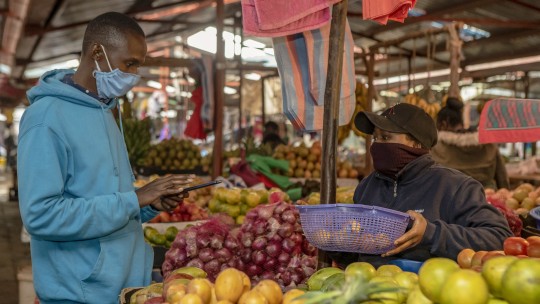How COVID-19 is impacting and changing East Africa’s agri-food systems

In this fourth report on emerging lessons from COVID-19, we look at the pandemic’s complex impacts on East African food systems and highlight the need for an inclusive policy response working closely with informal providers.
Beyond COVID-19: grassroots visions of change
This article is part of a new IIED series that offers forward-looking responses on key themes during the pandemic, drawing on our partners’ insights and providing a platform for voices from the global South.
Here, IIED researcher Giulia Nicolini looks at how COVID-19 is affecting East African food systems and highlights the need to develop a joined-up approach to managing risks.
Efforts to curb the spread of COVID-19 have severely disrupted agri-food supply chains in East Africa, putting a strain on the millions of people whose livelihoods depend on the food system as well as citizens who rely (to a greater or lesser extent) on purchased food.
A triple blow for agricultural production
Many small-scale farmers and agricultural workers have been devastated as foreign demand has plummeted for commodities such as flowers, coffee and fish, leading to mass layoffs and pay reductions in key export industries. Female workers in the Kenyan flower industry have described the acute stress caused by financial uncertainty, long working hours and caring for children while schools are closed.
Farmers have also faced the triple threat of COVID-19, a locust invasion, and extreme weather – causing floods in some regions and droughts in others. Efforts to tackle one crisis have sometimes been hampered by measures to curtail another.
Multiple timelines for impacts
The impacts of COVID-19 are likely to play out on different time scales, with many short-term shocks to production and trade giving way to longer-term consequences for other parts of the food system.
In a region heavily dependent on road freight for the trade of essential goods, COVID-19 testing regimes at East African borders have caused transport bottlenecks, leading to delays in delivering agri-food commodities. As a result, some farmers reported shortages of inputs such as seeds and fertilisers, which meant they were late in planting next season’s crops. In the long term, this could lead to decreased outputs of staple commodities, threatening both future livelihoods and wider food security.
Due to temporary stay-at-home orders, street food vendors in Kampala (most of whom are women) have suffered dramatic income losses; some have also reported being excluded from social protection schemes and subjected to police violence. In the long run, if marginalised groups such as informal vendors fall into acute poverty, this will not only impact their own food security, but also that of the many low-income urban residents (PDF) who rely on them for affordable, nutritious food.
Necessity is the mother of invention
In the face of crisis, many food system actors have found ways to adapt. In Kampala, some informal vendors have switched to door-to-door sales, while others are trialling e-commerce platforms. Farmers in Kenya are using social media to sell produce to local customers, buy inputs and communicate with extension service providers. And the Rwandan government has asked coffee mills to pay farmers using mobile payments.
But uneven access to digital services in East Africa (and elsewhere in the global South) means that technology provides only limited solutions to COVID-19’s challenges.
Looking ahead
Responses to the pandemic have temporarily reshaped food systems, shortening supply chains and increasing demand for local foods. In Ethiopia, the perceived COVID-related risks of consuming animal-sourced foods and raw vegetables led to a shift in demand away from these products. While some concerns may have subsided, there is evidence of a steady increase in the consumption of pasteurised and powdered milk, as well as value-added dairy products such as yoghurt in Kenya.
It remains uncertain which changes will outlast the pandemic, and who will benefit or lose. Small-scale transporters may lose out if supply chains shrink, while producers focused on high-value exports will likely lose income by pivoting to local markets. However, processors could benefit from shifts in consumer preferences.
To date, food system actors with precarious livelihoods that are already actively marginalised – including informal workers and women – have suffered the most from harsh responses to the pandemic. Instead, governments and local authorities should strive for more socially inclusive and gender-responsive approaches. Greater policy recognition is needed of the role that these low-income but vital actors play in ensuring food security and the functioning of supply chains, even under ‘normal’ circumstances.
Note: This article drew on research conducted by IIED and its partners as part of an IKEA Foundation-funded project on sustainable agriculture in Ethiopia, Kenya, Rwanda and Uganda.
Source : lied.org

